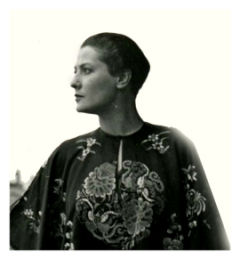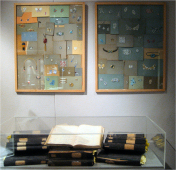Suzanne Belperron facts for kids
Suzanne Belperron (1900–1983) was a very important jewelry designer from Paris, France. She was born in Saint-Claude. Suzanne created unique and bold jewelry pieces. She worked for famous jewelry companies like Boivin and Herz. Later, she even took over the Herz company and renamed it Herz-Belperron. Many famous people, including kings, queens, artists, and movie stars, loved her designs.
Contents
Suzanne's Early Life and Education
Suzanne Belperron was born on September 26, 1900. Her full name was Madeleine Suzanne Marie Claire Vuillerme. She grew up in Saint-Claude, a town in eastern France. This area, near the Jura Mountains, was known for its stone cutting. People there had been crafting things for centuries.
Suzanne's mother saw her talent for design. She encouraged Suzanne to study at the School of Fine Arts in Besançon. This school was founded in 1773. In 1918, Suzanne won first prize in a "Decorative Art" contest. She won for a special pendant-watch design. This award showed how skilled she was in jewelry design.
Working at Boivin Jewelry House
In March 1919, Suzanne moved to Paris. This was the start of the "Golden Twenties" in the city. She began working as a designer for the Boivin jewelry house. The company's founder, René Boivin, had passed away. His widow, Jeanne Boivin, now ran the business.
From 1920, Boivin's jewelry collections featured Suzanne's ideas. Her designs were curvy and large. This was different from the popular Art Deco style of the time. Art Deco jewelry was usually very neat and geometric.
Jeanne Boivin saw Suzanne as very important to the company. Suzanne helped the Boivin jewelry house become famous worldwide. By 1924, at just 23 years old, Suzanne became a co-director.
In 1924, Suzanne married Jean Belperron, an engineer. They moved to Paris. Suzanne met many artists and writers in her new neighborhood. At Boivin, Suzanne became known for using unusual materials. She set precious stones in semi-precious materials. These included chalcedony, rock crystal, and smoky quartz.
Becoming Famous in the 1930s
Suzanne felt that her designs for Boivin were not getting enough credit. Jewelers often kept their designers' names a secret. In February 1932, she left Boivin.
In April 1932, Suzanne joined Bernard Herz's company. Herz was a well-known dealer of pearls and precious stones. He gave Suzanne the freedom to create her own designs. She worked from her private salon in Paris. Suzanne hired a skilled stonecutter, Adrien Louart. She also chose Groëné et Darde as her only manufacturer.
During the 1930s, Suzanne's unique work made Herz's company famous. Her fame grew in France and around the world. Her jewelry appeared in top fashion magazines. These included Vogue and Harper's Bazaar. Famous photographers like George Hoyningen-Huene took pictures of her pieces. Diana Vreeland, a major fashion icon, loved Suzanne's style.
Suzanne's Unique Style: "My Style is My Signature"
Suzanne Belperron was amazing with colors. Her designs often mixed ideas from different cultures. She was inspired by ancient Egypt, India, and the Far East. She also loved nature, like starfish, insects, and flowers. The underwater world also fascinated her.
Suzanne learned design during the Art Deco period. But she made her own softer style. She was a pioneer in setting valuable stones in less expensive materials. She also preferred 22-karat gold. She liked its soft color, even though it was less common.
Suzanne never signed her jewelry pieces. She believed her style was so unique that it was her signature. She was sure that people would recognize her work. This makes it harder for experts to identify her pieces today.
World War II and Herz-Belperron
Bernard Herz, Suzanne's business partner, was Jewish. During the German occupation of Paris, he faced danger. Suzanne tried to protect him from the Gestapo.
Because of unfair laws against Jewish people, Suzanne took control of the Herz company. This happened in November 1940. She wanted to keep the business going. She created a new company called "Suzanne Belperron SARL."
Suzanne kept working hard during the war. It was difficult to get materials for jewelry. In November 1942, Suzanne was arrested. Someone had reported that her business was secretly Jewish. She was taken to the Gestapo headquarters. On the way, she bravely swallowed her address book. This was to protect her clients and contacts. Bernard Herz was also arrested and sent to a concentration camp.
Suzanne was also part of the French Resistance. She refused offers to move to America. She chose to stay in Paris.
After the war, in 1946, Bernard Herz's son, Jean, returned. He had been a prisoner of war. Following his father's wishes, Jean and Suzanne formed a new company. They called it "Jean Herz-Suzanne Belperron SARL." They worked together successfully for 30 years.
Jewelry for Famous Clients
Suzanne met her clients by appointment only. Her salon was on the third floor of a building in Paris. She never opened a public store. She believed her jewelry spoke for itself. Her address was shared quietly, by word of mouth.
Before making any piece, Suzanne learned about her client's life. She also studied their face, skin, and hands. She took exact measurements, like a fashion designer. She even had "fittings" to make sure each piece was perfect.
Suzanne carefully watched every step of the jewelry making process. She met daily with the workshop head. She wanted everything to be perfect.
Suzanne's clients included royal families and famous people. These included the Aga Khan and the Rothschild family. She also designed for actors, writers, and artists. Some famous names were Colette, Josephine Baker, Jean Cocteau, and Gary Cooper. Fashion designers like Elsa Schiaparelli and Christian Dior were also her clients.
Later Life and Legacy
In 1963, Suzanne received a high honor. She was made a Knight of the Légion d'Honneur. This is a very important award in France.
Suzanne's husband died in 1970. In 1974, she and Jean Herz decided to close their company. The Herz-Belperron company officially closed in 1975. But Suzanne still worked. Her loyal clients asked her to value their jewelry. She helped with pieces for inheritance, insurance, or museum gifts. She refused offers from companies like Tiffany & Co. to remake her designs.
Suzanne Belperron died in an accident in 1983, at age 82. She had no children. She left her belongings to a close friend.
From Forgotten to Famous Again
Duchess of Windsor's Jewelry Auction
Suzanne Belperron's name was mostly forgotten for a while. But that changed in 1987. Sotheby's held a big auction in Geneva. It was for the jewelry collection of the Duchess of Windsor. Only a few of Suzanne's pieces were correctly identified at first. But this auction brought her work back into the spotlight.
Discovery of Personal Archives
In 2007, Suzanne's last heir passed away. A new heir inherited her estate. This included her personal archives. People used to think Suzanne had burned her records. But this was not true. The new heir found a small apartment that had been closed since 1983. Inside were Suzanne's furniture, books, and all her archives.
These archives included drawings, sketches, business letters, and daily appointment books. This discovery was very important. It helped prove the `authenticity` and history of her jewelry. It showed that many stories about Suzanne were wrong.
An expert named Olivier Baroin bought Suzanne's archives in 2008. He was given the job of making sure her work is always recognized. He helps authenticate and certify her jewelry.
Recent Sales of Belperron Jewelry
Suzanne Belperron's jewelry is still very valuable today. In 2010, a brooch with emeralds and diamonds sold for over $674,000. In 2011, a colorful bracelet sold for over $330,000.
In 2012, Karl Lagerfeld, a famous fashion designer, used one of her chalcedony jewels. It helped set the style for the Chanel spring-summer collection. Also in 2012, Suzanne's own jewelry collection was sold. The 60 pieces sold for three times more than expected.
See also
 In Spanish: Suzanne Belperron para niños
In Spanish: Suzanne Belperron para niños



